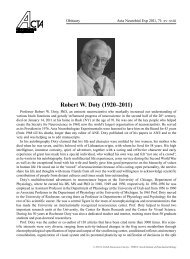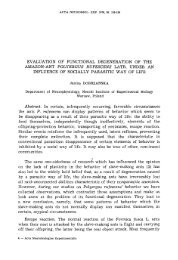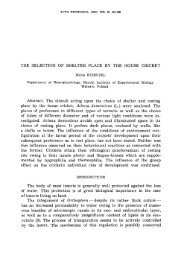Auditory perception of temporal order in centenarians in comparison ...
Auditory perception of temporal order in centenarians in comparison ...
Auditory perception of temporal order in centenarians in comparison ...
You also want an ePaper? Increase the reach of your titles
YUMPU automatically turns print PDFs into web optimized ePapers that Google loves.
380 I. Kolodziejczyk and E. Szelag<br />
Der G, Deary IJ (2006) Age and sex differences <strong>in</strong> reaction<br />
time <strong>in</strong> adulthood: results from the United K<strong>in</strong>gdom<br />
Health and Lifestyle Survey. Psychol Ag<strong>in</strong>g 21: 62–73.<br />
Divenyi PL, Hirsh IJ (1974) Identification <strong>of</strong> <strong>temporal</strong> <strong>order</strong><br />
<strong>in</strong> three-tone sequences. J Acoust Soc Am 561:<br />
144–151.<br />
F<strong>in</strong>k M, Churan J, Wittmann M (2005) Assessment <strong>of</strong> auditory<br />
<strong>temporal</strong>-<strong>order</strong> thresholds – a <strong>comparison</strong> <strong>of</strong> different<br />
measurement procedures and the <strong>in</strong>fluences <strong>of</strong> age<br />
and gender. Restor Neurol Neurosci 23: 1–16.<br />
F<strong>in</strong>k M, Ulbrich P, Churan J, Wittmann M (2006) Stimulusdependent<br />
process<strong>in</strong>g <strong>of</strong> <strong>temporal</strong> <strong>order</strong>. Behav Process<br />
71: 344–352.<br />
Fitzgibbons PJ, Gordon-Salant S (1994) Age effects on measures<br />
<strong>of</strong> auditory duration discrim<strong>in</strong>ation. J Speech Hear<br />
Res 37: 662–670.<br />
Fitzgibbons PJ, Gordon-Salant S (1995) Age effects on duration<br />
discrim<strong>in</strong>ation with simple and complex stimuli. J<br />
Acoust Soc Am 98: 3140–3145.<br />
Fitzgibbons PJ, Gordon-Salant S (1998) <strong>Auditory</strong> <strong>temporal</strong><br />
<strong>order</strong> <strong>perception</strong> <strong>in</strong> younger and older adults. J Speech<br />
Lang Hear Res 41: 1052–1060.<br />
Folste<strong>in</strong> MF, Folste<strong>in</strong> SE, McHugh PR (1975) “M<strong>in</strong>i-Mental<br />
State”: A practical method for grad<strong>in</strong>g the cognitive state<br />
<strong>of</strong> patients for the cl<strong>in</strong>ician. J Psychiatr Res 12: 189–198.<br />
Gibon J, Church RM (1984) Sources <strong>of</strong> variance <strong>in</strong> an <strong>in</strong>formation<br />
process<strong>in</strong>g theory <strong>of</strong> tim<strong>in</strong>g. In: Animal Cognition<br />
(Roitblat HL, Bever TG, Terrace HS, Eds). Erlbaum,<br />
Hillsdale, NJ, p. 465–488.<br />
Gordon-Salant S, Fitzgibbons PJ (1999) Pr<strong>of</strong>ile <strong>of</strong> auditory<br />
<strong>temporal</strong> process<strong>in</strong>g <strong>in</strong> older listeners. J Speech Lang<br />
Hear Res 42: 300–311.<br />
Gottsdanker R (1982) Age and simple reaction time. J<br />
Gerontol 37: 342–348.<br />
Güçlü B, Murat A (2007) Active touch does not improve<br />
sequential process<strong>in</strong>g <strong>in</strong> a count<strong>in</strong>g task. Acta Neurobiol<br />
Exp (Wars) 67: 165–169.<br />
Gunstad J, Cohen RA, Paul RH, Luyster FS, Gordon E<br />
(2006) Age effects <strong>in</strong> time estimation: relationship to frontal<br />
bra<strong>in</strong> morphometry. J Integr Neurosci 5: 75–87.<br />
Hirsh IJ, Sherrick CE (1961) Perceived <strong>order</strong> <strong>in</strong> different<br />
sense modalities. J Exp Psychol 62: 423–432.<br />
Ho SC, Woo J, Sham A, Chan SG, Yu AL (2001) A 3-year<br />
follow-up study <strong>of</strong> social, lifestyle and health predictors<br />
<strong>of</strong> cognitive impairment <strong>in</strong> a Ch<strong>in</strong>ese older cohort. Int J<br />
Epidemiol 30: 1389–1396.<br />
Kanabus M, Szelag E, Rojek E, Poppel E (2002) Temporal<br />
<strong>order</strong> judgment for auditory and visual stimuli. Acta<br />
Neurobiol Exp (Wars) 62: 263–270.<br />
Kimura D (1999) Sex and Cognition. MIT Press, Cambridge,<br />
MA.<br />
Kiss M, Cristescu T, F<strong>in</strong>k M, Wittmann M (2008) <strong>Auditory</strong><br />
language comprehension <strong>of</strong> <strong>temporal</strong>ly reversed speech<br />
signals <strong>in</strong> native and non-native speakers. Acta Neurobiol<br />
Exp (Wars) 68: 204–213.<br />
Le Carret N, Lafont S, Letenneur L, Dartigues J-F, Mayo W,<br />
Fabrigoule C (2003) The effect <strong>of</strong> education on cognitive<br />
performances and its implication for the constitution <strong>of</strong> the<br />
cognitive reserve. Dev Neuropsychol 233: 317–337.<br />
Lemaire P, Arnaud L, Lecacheur M (2004) Adults’ age-related<br />
differences <strong>in</strong> adaptivity <strong>of</strong> strategy choices: evidence from<br />
computational estimation. Psychol Ag<strong>in</strong>g 193: 467–481.<br />
Letenneur L, Gilleron V, Commenges D, Helmer C, Orgogozo<br />
JM, Dartigues JF (1999) Are sex and educational level<br />
<strong>in</strong>dependent predictors <strong>of</strong> dementia and Alzheimer’s disease?<br />
Incidence data from PAQUID project. J Neurol<br />
Neurosurg Psychiatry 66: 177–183.<br />
Lezak MD (1995) Neuropsychological Assessment (3rd edition).<br />
Oxford University Press, New York, NJ.<br />
Lotze M, Wittmann M, von Ste<strong>in</strong>büchel N, Poppel E,<br />
Roenneberg T (1999) Daily rhythm <strong>of</strong> <strong>temporal</strong> resolution<br />
<strong>in</strong> the auditory system. Cortex 35: 89–100.<br />
Lustig C, Meck WH (2001) Pay<strong>in</strong>g attention to time as one<br />
gets older. Psychol Sci 12: 478–484.<br />
Mart<strong>in</strong> JS, Jerger JF (2005) Some effects <strong>of</strong> ag<strong>in</strong>g on central<br />
auditory process<strong>in</strong>g. J Rehabil Res Dev 42: 25–44.<br />
McCormack T, Brown GD, Maylor EA, Darby RJ, Green D<br />
(1999) Developmental changes <strong>in</strong> time estimation: compar<strong>in</strong>g<br />
childhood and old age. Dev Psychol 35: 1143–1155.<br />
Me<strong>in</strong>z EJ, Salthouse TA (1998) Is age k<strong>in</strong>der to females than<br />
to males? Psychon Bull Rev 51: 56–70.<br />
Mills L, Rollman GB (1980) Hemispheric asymmetry for<br />
auditory <strong>perception</strong> <strong>of</strong> <strong>temporal</strong> <strong>order</strong>. Neuropsychologia<br />
18: 41–47.<br />
Nebes RD (1978) Vocal versus manual response as a determ<strong>in</strong>ant<br />
<strong>of</strong> age difference <strong>in</strong> simple reaction time. J Gerontol<br />
33: 884–889.<br />
Oldfield RC (1971) The assessment and analysis <strong>of</strong> handedness:<br />
The Ed<strong>in</strong>burgh Inventory. Neuropsychologia 9:<br />
97–113.<br />
Phillips JG, Schiffter T, Nicholls MER, Bradshaw JL, Iansek<br />
R, Sal<strong>in</strong>g LL (1999) Does older age or Park<strong>in</strong>son’s Disease<br />
cause bradyphrenia? J Gerontol (A Biol Sci Med Sci)<br />
54A8: M404–M409.<br />
Phillips SL, Gordon-Salant S, Fitzgibbons PJ, Yeni-Komshian<br />
GH (1994) <strong>Auditory</strong> duration discrim<strong>in</strong>ation <strong>in</strong> young and<br />
elderly listeners with normal hear<strong>in</strong>g. J Am Acad Audiol 5:<br />
210–215.









